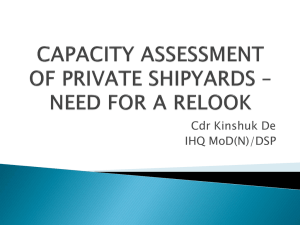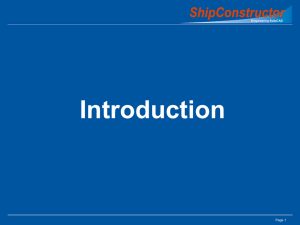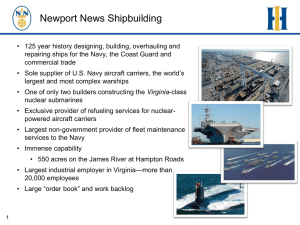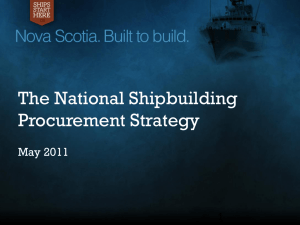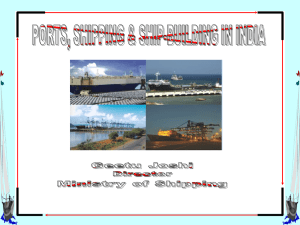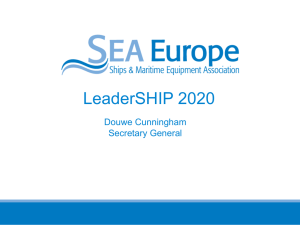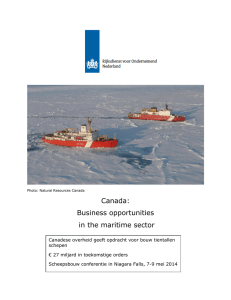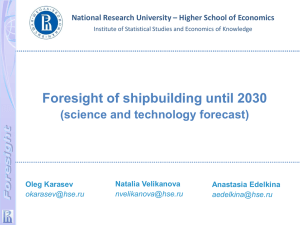3. Revised summary information on the European and
advertisement
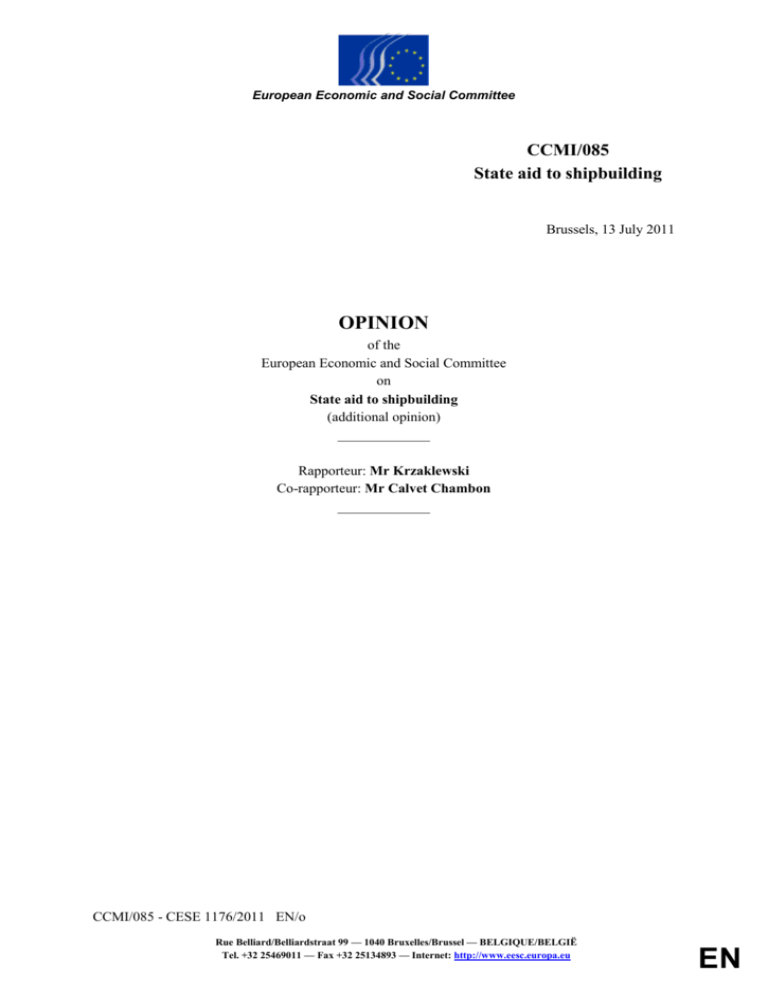
European Economic and Social Committee CCMI/085 State aid to shipbuilding Brussels, 13 July 2011 OPINION of the European Economic and Social Committee on State aid to shipbuilding (additional opinion) _____________ Rapporteur: Mr Krzaklewski Co-rapporteur: Mr Calvet Chambon _____________ CCMI/085 - CESE 1176/2011 EN/o Rue Belliard/Belliardstraat 99 — 1040 Bruxelles/Brussel — BELGIQUE/BELGIË Tel. +32 25469011 — Fax +32 25134893 — Internet: http://www.eesc.europa.eu EN -1On 9 December 2010, the European Economic and Social Committee, acting under Rule 29(A) of the Implementing Provisions of its Rules of Procedure, decided to draw up an opinion on State aid to shipbuilding (additional opinion). The Consultative Commission on Industrial Change, which was responsible for preparing the Committee's work on the subject, adopted its opinion on 7 June 2011 At its 473rd plenary session, held on 13-14 July (meeting of 13 July), the European Economic and Social Committee adopted the following opinion by 124 votes to 5 with 6 abstentions. * * * 1. Conclusions and recommendations 1.1 The European Economic and Social Committee is convinced that the Framework on State aid to shipbuilding is an instrument which should be maintained; there is a need, however, to update and extend some of its provisions. The Framework contributed to the achievement of the addressed political and economic objectives during its period of application. The continued existence of the Framework is mainly justified by sector-specific circumstances, which are outlined in the introduction to the current Framework. 1.2 The Committee wishes to emphasise that the Framework is not a short-term measure for combating the crisis but takes account of the specific circumstances of the sector and that the assistance provided for under the Framework should not reward or encourage the construction of ships that are uncompetitive or vessels that have low technical specifications. 1.3 The EESC believes that the recent news about the collapse – after twenty years of discussion – of the OECD-sponsored negotiations on a multilateral agreement establishing normal competitive conditions in the commercial shipbuilding industry is another argument which bears witness to the unique situation of the shipbuilding industry, which requires the maintenance and revision of the Framework. 1.4 Further on in the opinion, the Committee looks in detail at a number of fundamental questions and problems which the Commission put to the stakeholders as part of the consultation process. The EESC puts forward and justifies a number of modifications which it considers should be introduced into the revised version of the Framework. CCMI/085 - CESE 1176/2011 EN/o .../... -21.5 The Committee considers that aid for research, development and innovation (RDI), as provided for in the Framework, is essential as it helps shipbuilders accept the specific types of risk related to innovation. 1.5.1 The Committee considers that availability of innovation aid has a positive impact on risk assessments of each innovative element in the development of new products or processes. It allows companies to take additional steps towards new solutions, increasing the chances of market success for innovative products and, in consequence, stimulating further RDI activities. 1.6 Regarding the Commission's question as to whether it would be appropriate to exclude other types of innovation from eligibility for innovation aid and only keep innovation if linked to "greener" ships, the Committee endorses the position of the social partners and considers that this would significantly weaken the effectiveness of this instrument. In particular, its highly positive impact on process and other product-based innovation in such fields as safety or productivity would be lost. 1.7 The Committee notes that aid instruments aimed at facilitating the market penetration of "green technologies" are an important tool and should be incorporated into the Framework. The revised Framework should include a set of appropriate and practical provisions relating to this issue, together with the requirements for the cross-cutting measures on environmental protection. In the view of the EESC, such provisions will not serve to set up an additional state aid instrument but will simplify the application of the Framework and will make it possible to achieve key EU objectives. 1.8 Regarding the fundamental question raised by the Commission – whether RDI aid should be maintained in the Framework due to the existence of horizontal rules on RDI – the Committee stresses firmly that given the specific nature of the shipbuilding sector, RDI aid, as provided for in the Framework, must be maintained as the horizontal rules do not provide appropriate solutions supporting innovation in the shipbuilding sector. 1.9 Considering that there was no incentive for applying closure aid during the period between the Framework's introduction in 2004 and the crisis of 2009-2010 and given that the situation has deteriorated so drastically in recent years that orders in EU shipyards have fallen to their lowest levels in over a decade, the Committee believes that this form of aid should be maintained. The rules on such aid should allow shipyards to carry out partial restructuring without the need to go through the fully-fledged restructuring process under the Rescue and Restructuring Guidelines. 1.10 The Committee is convinced that regional aid is also beneficial for the shipbuilding sector. Regional aid under the Framework should ensure the same aid intensities as action applicable under the Regional Aid Guidelines. The EESC believes that limiting the scope of such aid in the Framework to existing yard installations is neither adequate nor justified. CCMI/085 - CESE 1176/2011 EN/o .../... -3- 1.11 The application of restrictive EU rules for shipbuilding capacity expansion has had an opposite effect to the one intended. Instead of limiting the contribution to global overproduction, it has placed European shipyards at a further disadvantage vis à vis their global competitors. Therefore, the maintenance of rules aimed at minimising support for capacity extension can, in the Committee's view, no longer be justified. 1.12 Regarding the rules on employment aid provided for under the Framework, the EESC calls on the Member States to employ these measures more frequently than in the past particularly in order to support the action of shipbuilders in their countries in the areas of education and training. 1.13 The Committee considers that the clause on export credits should be maintained within the Framework. Export credits granted in accordance with the OECD sector agreement do not constitute state aid and support businesses, and therefore the regions in which they are located. It is directly linked to maintaining or increasing employment in the sector and businesses connected with it and to benefits for EU ship owners (possibility of obtaining long-term loans or credit guarantees to purchase ships). 1.14 The Committee supports expanding the range of products included in the Framework, which is necessary due to developments in the shipbuilding sector and its technologies since 2004. The EESC considers that, to this end, we should make use of the CESA's updating proposal set out in its opinion on Article 2 of the Framework1. 1.15 The Committee calls on the EU Member States and the EU administration to pay particular attention to the policy of providing information on the opportunities and conditions for employing state aid, as provided for under the Framework. 2. Introduction Background to the opinion 2.1 On 29 April 2010, the EESC adopted an own-initiative opinion entitled The European shipbuilding industry dealing with the current crisis. 2.2 As part of its 2011 work programme, the European Commission plans to carry out a review of the Framework on State aid to shipbuilding, leading to its possible revision or prolongation beyond 2011. Official consultations were held with stakeholders, including the social partners, as well as the Member States, which were concluded on 6 December 2010. 1 Review of the Framework on State Aid to Shipbuilding – CESA response to the consultation paper – supplement (2010). CCMI/085 - CESE 1176/2011 EN/o .../... -42.2.1 An additional EESC opinion on this issue would be useful and timely given the economic and social ramifications of these rules and the significant impact they have on specific regions. 2.3 The Framework on State aid to shipbuilding lays down the rules to be applied by the Commission in assessing State aid to shipbuilding. The Framework entered into effect on 1 January 2004 for an initial period of three years. The Commission has since extended its life twice, in 2006 for a further two-year period, and in 2008 for a further three years. The Framework is thus currently due to expire on 31 December 2011. 2.4 The general principle of the Framework is that shipbuilding is eligible for aid under the horizontal state aid instruments, except where the specific provisions of the Framework apply. These specific provisions concern the following areas: aid to research, development and innovation, closure aid, employment aid, export credits, development aid and regional aid. 2.5 Given that shipbuilding is also eligible for aid under the horizontal State (and EU) aid instruments, the consultations, and the EESC opinion issued on behalf of EU civil society, should above all help determine whether the specific provisions of the Framework should continue to be applied and suggest whether - and if so how - they should be amended in the event of their extension. 3. Revised summary information on the European and shipbuilding sector in a global context ahead of the decision on the Framework 3.1 A comprehensive and wide-ranging presentation of the European shipbuilding sector was set out in the EESC opinion of April 2010. The information below is from last year. 3.2 After the first period of crisis, it is clear that the shipbuilding sector has been hard hit worldwide. There has been an unprecedented level of trade disruption and all shipbuilding countries have encountered substantial difficulties due to the huge fall in demand. Coupled with the - as yet - unresolved issue surrounding the lack of a level playing field for shipbuilding and maritime trade, Europe's long-term prospects in this area are now seriously endangered. 3.3 Asian countries currently account for over 80% of global ship construction, while their order portfolio represents as much as 90% of the global total. The growth in the position of these countries is taking place at the expense of EU countries, whose share in worldwide shipbuilding has shrunk to its current level of 7-8%. 3.3.1 Europe's share of new orders worldwide plummeted to 2.7% in 2009, but recovered to 4.8% during the first three quarters of 2010. However, if we consider order book figures by volume, while the global index crept up slightly in 2010, in the EU it remained at a similar level to that of 2009, its lowest level for a decade. CCMI/085 - CESE 1176/2011 EN/o .../... -53.3.2 The global total of new ship orders by volume in recent years was as follows: in 2007 85 million CGT, in 2008 - 43 million CGT, in 2009 - 16.5 million CGT. In the first three quarters of 2010, however, it grew to 26.3 million CGT (forecast as at end-2010 approximately 35 million CGT). In 2009, the planned construction of many already contracted vessels was cancelled due, among other things, to very low freight rates and the unavailability of bank loans to finance shipbuilding. 3.3.3 The price index, calculated in euros, has recovered by some 17% since the first quarter of 2010 (when it reached its lowest level for ten years) although exchange rate fluctuations have depressed prices expressed in some national currencies. Although the index has risen by over 20% since 2000, in euro terms prices have remained static. 3.4 The crisis aside, most of the instability in the shipbuilding sector is still the result of intervention and protectionism by those countries where shipbuilding is, or aspires to be, a key sector of the economy. Certain shipyards, primarily in the Far East, which receive government support are able to offer their products and services at prices which do not take account of all types of risk, and which are therefore lower than those of their competitors, primarily in Europe, who must factor such types of risk into their price calculations. The exchange rate can represent yet another tool of protectionism (as one of the factors determining competitiveness) which can be centrally guided to a certain extent (e.g. in China as well as in South Korea). 3.5 In December 2010, the OECD decided not to recommence negotiations on the agreement respecting normal competitive conditions in the commercial shipbuilding industry. The collapse of these negotiations after 20 years of discussions means that the global shipbuilding market will continue to be an arena for ruthless competition. This is a particularly negative turn of events, which has encouraged certain countries to apply various means of market intervention even more widely. The result of this is the creation of an even more uneven playing field within the global shipbuilding industry. The blame for this state of affairs lies with the intransigence of certain non-EU countries with shipyards: China and South Korea. 3.5.1 This turn of events is seen as a reaction to the global crisis and provides fertile ground for the introduction of protectionist measures. There is a greater risk that ships will be built on the global market which have no economic raison d'être. These newly launched vessels will aggravate the crisis on the freight market i.e. too many ships will be competing for the same cargoes. The multiple negative impact on all market players (production overcapacity, downward pressure on shipyard prices, surplus tonnage, depressed charter rates) has already been the subject of a complaint from the European social partners from the shipbuilding sector. 3.6 Employment in the sector has plummeted across the EU since 2008. Some 40 000 jobs have been lost and all stakeholders are calling for the introduction of a contingency programme to CCMI/085 - CESE 1176/2011 EN/o .../... -6ensure the European shipbuilding sector retains critical mass2 This trend is further compounded by the recent application of the Basel III Capital Framework for Banking Supervision which restricts conditions of financing. 3.7 Since the financial crisis began, it has become significantly more difficult to obtain financing for shipbuilding in the EU as a number of key financial institutions have reduced or indeed withdrawn their financial involvement prior to (pre-financing) and after ship delivery. Given this situation, public guarantee instruments, including for export credits, have therefore become significantly more important. The credit crisis in the shipbuilding sector is still continuing despite early signs of a possible market upturn. 3.8 While the ship repair subsector, which is considered to be part of the shipbuilding sector, also experiences periodic difficulties, it is in a much better situation than the yards specialising in construction. Ship repair yards operate on a different market to the shipbuilding industry (over half of all vessels undergoing repair are from outside the EU). This subsector was not spared by the global crisis of 2009-2010 as ship owners significantly cut spending on ship repair, often limiting such repairs to essential or periodic repair work required by maritime regulations. 3.8.1 Given the fierce competition on the global market, ship repair yards in a number of EU countries have taken action to diversify their production by focusing on modernising (retrofitting) vessels and carrying out more complex operations such as: hull extension as well as other reconditioning including for equipment for deep sea oil and gas extraction or the production of smaller vessels. 3.8.2 At present, ship repairs are largely carried out in shipyards located in the EU's neighbouring countries. The EESC urges the EU Member States and EU administration to draw up a strategy to stimulate the development and construction of these types of shipyards in the EU's coastal areas. It is in the interest of EU Member States to maintain a “strategic minimum” of repair facilities in the EU to serve its shipping sector. These yards could repair ships at competitive prices, ensure the timely completion of contracts and the use of "green" methods, while at the same time contributing to the industrial regeneration of certain coastal regions. 4. General comments 4.1 The general aim of the review of the Framework should be to improve the conditions under which European shipyards compete. This spirit should pervade all its provisions. 4.2 The global competitiveness of Europe's shipbuilding sector is coming under immense pressure as a result of the difficult market conditions, particularly due to the large amount of support available in competitor countries. As the European sector is unable to compete on 2 EESC opinion CCMI/069 – OJ C 18, 19.1.2011. CCMI/085 - CESE 1176/2011 EN/o .../... -7labour costs, it must seek to gain an advantage by ensuring the highest possible quality in terms of ship safety, efficiency and protection of the marine environment, as well as through the introduction of innovative processes aimed at further improving efficiency. It is clear that the revised and revamped Framework will be capable of providing the appropriate incentives to achieve this, which are vital if the objectives are to be attained. 4.3 It is essential for the updated Framework to immediately set up a practical system of incentives facilitating investments in newly built or modernised vessels with higher environmental specifications. Failure to implement a system of this kind in the short term could make it impossible to achieve any rapid economic benefits from the reduction of nitrogen oxides, sulphur oxides or greenhouse gas emissions. The Framework should stipulate that this type of aid and the resources allocated to it must be restricted to European shipbuilders. 4.4 Aid granted under the Framework is important both for individual companies and regions. Accordingly, there is a need to introduce new innovative projects enabling shipyards to respond to the changing needs of the market as quickly and effectively as possible. To be eligible for aid innovative projects would have to include investment in both new product R+D+I and in training and upgrading employee skills. The renewed Framework should take this into account. 4.5 The Committee believes that before examining the issue of export credits in detail (see specific comments), it should be stressed that access to competitive financing is often of decisive importance when securing new shipbuilding projects. The involvement of public authorities, state-owned banks and other state institutions in financing prior to (pre-financing) and after ship delivery has increased significantly in recent years, especially in Asia. It is probably safe to assume that over the short to medium term, shipbuilding will be financed with support in the form of public loans or guarantees, also in the EU, with the involvement of national and EU financial institutions e.g. EIB (where the sector has experienced difficulties3). 4.6 Since the first EU Shipbuilding Framework was established, the sector has undergone many structural changes, which should be taken into account when formulating new provisions. They are as follows: 3 European shipyards have made significant progress towards specialisation, a process which must be continued and supported; there has been a significant decrease in the share of standard vessels in the order portfolio of the European shipbuilding industry; global competition is also becoming apparent in the case of smaller vessels, including inland waterway vessels; See EESC opinion CCMI/069 – OJ C 18, 19.1.2011. CCMI/085 - CESE 1176/2011 EN/o .../... -8 while the average size of European shipyards has remained constant or decreased slightly over the past ten years (following the closure of shipyards in Poland, Croatia, Denmark and Spain), Europe is now having to come to terms with the mass expansion of shipyards in its competitor countries, particularly in Asia; the importance of environmentally friendly products and production processes has grown significantly; this trend should be encouraged by necessary action on emissions, particularly sulphur oxides, nitrogen oxides and greenhouse gases; the growth of coastal shipping means that the European shipbuilding industry needs to find a way to meet local demand. 4.7 The approach adopted by the EU Member States when employing the aid measures provided for under the Shipbuilding Framework is particularly important; they must provide information in a comprehensive and systematic manner about the opportunities and conditions for obtaining state aid (not subsidies) as provided for under the Framework. 5. Specific comments Aid for RDI 5.1 RDI activity is essential if companies are to offer better products and, consequently, be successful on the market. However, RDI activities may only be conducted if the market is prepared to accept the specific types of risk related to innovation. 5.2 As has been stressed by European shipbuilders, the risk exposure related to the production of prototype ships is substantial. Unlike most other sectors, sales contracts in shipbuilding stipulate product performance definitions which are untested at the time of signature. Even small incidents related for example to one innovative element can be the origin of changes requiring significant additional resources and time and causing substantial disruptions of the production process. 5.2.1 In this situation, the availability of innovation aid has a positive impact on risk assessments of each innovative element in the development of new products or processes. It allows companies to take additional steps towards new solutions, increasing the chances of market success for innovative products and, in consequence, stimulating further RDI activities. 5.3 Using innovation aid produces an accelerating effect, which is an important factor leading to greater efficiency and competitiveness, which is crucial in order to maintain technological leadership in the field of complex and innovative ship types. The speed of innovation is a crucial element of competitiveness, particularly considering the limited possibilities for the protection of intellectual property in maritime technology. 5.4 The European social partners from the shipbuilding sector all agree – on the basis of specific examples – that aid for innovation has clearly contributed to an increase in efficiency and CCMI/085 - CESE 1176/2011 EN/o .../... -9competitiveness for the EU's shipyards. It has made it easier to introduce and disseminate new production methods, technologies and products and stimulate RDI. Accordingly, it should be considered to be an appropriate instrument of EU policy. 5.5 Entrepreneurs believe that problems with the application of the rules on aid for innovation can be corrected without modifying the text of the Framework but rather by revising the notified national programme to alter the block exemption threshold for product innovation relating to small ships and process innovation. 5.6 Regarding the Commission's question as to whether it would be more appropriate to exclude other types of innovation from eligibility for innovation aid and only maintain innovation when it is linked to "greener" ships, the Committee endorses the position of the social partners and considers that it would significantly weaken the effectiveness of this instrument. In particular, its highly positive impact on process innovation aimed at improving the competitiveness of European industry would be lost. Moreover, a number of product innovations e.g. linked to improved safety, security or crew and passenger comfort could no longer be supported. 5.6.1 Support instruments to facilitate market penetration of "green technologies" are an important tool which deserves to be incorporated into the Framework as environmental aid, complementing innovation aid, yet taking the form of a separate instrument. 5.7 Incentives to go beyond regulatory requirements should be introduced along the lines of the State aid framework for environmental protection. However, the application of this horizontal framework to the shipbuilding sector has hardly advanced. Appropriate and practical provisions along with the requirements of the horizontal rules should therefore be incorporated into the Shipbuilding Framework. One effective means of doing this would be to refer to the rules on environmental aid under the rules on block exemptions in tandem with the specific requirements for ships. This would be an effective contribution to the simplification of EU state aid rules. 5.8 The horizontal RDI Framework also includes provisions for innovation activities, including "the development of commercially usable prototypes and pilot projects […] where the prototype is necessarily the final commercial product and where it is too expensive to produce for it to be used only for demonstration and validation purposes"4. 5.8.1 The respective provisions actually foresee higher aid intensities than the Framework and, to some extent, a wider ranger of eligible costs. However, they also stipulate that "in case of subsequent commercial use of demonstration or pilot projects, any revenue generated from such use must be deducted from the eligible costs"5. 4 5 Commission Regulation (EC) No 800/2008 of 6 August 2008 (OJ L 214, 9.8.2008). Ibid. CCMI/085 - CESE 1176/2011 EN/o .../... - 10 - 5.8.2 Whereas this provision is workable in most manufacturing sectors due to series production where development costs are amortised over a larger number of products, it is unworkable for prototype ships. 5.9 Summing up, the Committee notes that, owing to the particularities of the shipbuilding sector, the horizontal RDI Framework does not offer an appropriate solution for innovation aid for shipbuilding and the best solution would therefore be to include appropriate provisions in the updated Framework. Closure aid 5.10 During the period between the introduction of the Framework in 2004 and the beginning of the crisis, shipbuilding experienced a period of strong demand, which meant there was little incentive for the industry to consider any facility closures. This demand situation has changed dramatically over the past two years with the order book of the European industry declining to its lowest level in more than a decade. 5.10.1 The Committee therefore believes that in the light of the current market situation the maintenance of this form of aid is justified6. 5.11 The provisions on this type of aid should allow shipyards to partly restructure7, without the need to go through the fully-fledged restructuring process under the Rescue and Restructuring Guidelines; this model should be taken over when reviewing those guidelines. If this was done, then of course there would be no need to maintain separate provisions on restructuring aid in the Shipbuilding Framework. Regional aid 5.12 In the event that regional aid rules are maintained, the scope and aid intensities need to be aligned with the ones applicable under the Regional Aid Guidelines. Limiting its scope to existing yard installations is neither adequate nor justified. The European shipbuilding industry needs to invest in more efficient production methods and facilities in order to strengthen its competitive position. This may make it necessary to create larger production units, in order to use synergies, become more efficient and use economies of scale. The current rules hamper, or make impossible, the granting of regional aid for such projects. 5.13 Huge investments in Asia have been the key driver of these countries' successful development. These investments have often been facilitated by direct or indirect state support. 6 7 Spain, among other countries, is planning to use "closure aid" in the near future for several shipyards (partial restructuring). Restructuring aid is defined in the appropriate horizontal rules, which are scheduled to be reformed in 2012. Aid for partial restructuring is expected to be included in this reform. CCMI/085 - CESE 1176/2011 EN/o .../... - 11 The restrictive European rules for shipbuilding capacity expansion have taken the opposite direction; this has placed the European industry at a further disadvantage compared to its global competitors. Therefore, the maintenance of restrictive rules, aimed at minimising support for capacity expansion, can no longer be justified. 5.14 The key problems in terms of the interpretation or application of the current regional aid rules concern the restrictive nature of the Framework's regional aid rules compared to the horizontal provisions. In particular, the strict interpretation of limiting the aid to investments in existing installations has unreasonably narrowed the scope of this instrument and has caused significant problems with its application. Employment aid 5.15 The EESC is convinced that employment aid should be maintained within the Framework. 5.15.1 The Committee considers that the Member States should employ the employment aid measures set out in the Framework more frequently to support the action of shipbuilders in their countries in the areas of education and training in crisis situations caused by market cycles, global overproduction or unfair competition from non-EU shipyards. Aid for export credits and development 5.16 Export credits provided by state-owned export credit agencies are common practice in various industrial sectors around the world. Sectoral agreements at OECD level provide the internationally accepted standards. All EU Member States are fully committed to the rules, which in the context of EU state aid rules are also considered fully compatible with the internal market. 5.17 Export credit facilities are an important element in the financing of shipbuilding projects. In Europe, they are intended to cover costs and therefore do not constitute subsidies. Their availability under competitive conditions contributes significantly to the competitiveness of the European industry. Particularly in the light of extensive financing packages made available by other major shipbuilding nations, in particular China and South Korea, Member States must be encouraged to provide their companies with equivalent tools. CCMI/085 - CESE 1176/2011 EN/o .../... - 12 5.18 The Committee considers that it is important to establish – using the opportunities provided by sectoral dialogue – the extent to which a reference to the OECD provisions in the Shipbuilding Framework is necessary or useful. The social partners in the shipbuilding sector consider this question one for the administrations to address, should the continued availability of the current export credit systems be put at risk. Brussels, 13 July 2011. The President of the European Economic and Social Committee Staffan Nilsson _____________ CCMI/085 - CESE 1176/2011 EN/o

